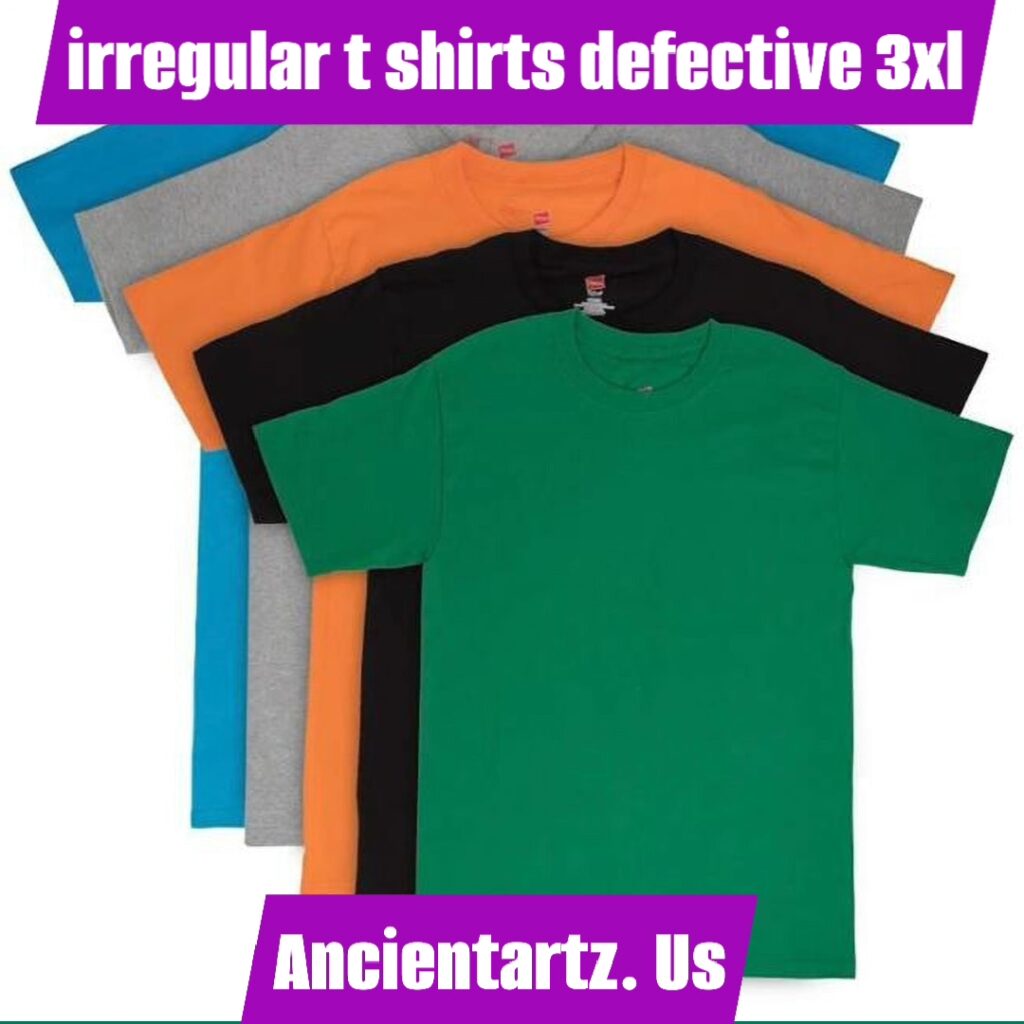Introduction: The Irregular T-Shirt Market and Defective 3XL
In today’s fast-paced fashion industry, where trends and consumer demands evolve rapidly, clothing manufacturers are often tasked with producing large quantities of garments to meet the ever-growing market needs. The t-shirt, a staple in nearly every wardrobe across the world, stands as one of the most versatile and popular items. However, like all mass-produced goods, t-shirts may occasionally come with defects or irregularities. This leads to an entire segment of the market dedicated to what is known as “ irregular t shirts defective 3xl“—items that do not meet the standard quality control expectations. These products are often sold at a discounted price, offering an opportunity for consumers to purchase items at a fraction of the cost. One particular category of irregular t-shirts that has garnered attention is the defective 3XL size. This category stands out due to the challenges associated with producing garments in larger sizes. These challenges can range from discrepancies in the dimensions of the fabric to faulty stitching or color inconsistencies, all of which may affect the final product. This article aims to explore the nature of irregular t-shirts and defective 3XL sizes, delving into why they occur, how they are perceived in the market, and the impact they have on consumers and manufacturers. In addition, we will examine the broader context of fashion quality control, size inclusivity, and the growing demand for affordable yet fashionable clothing.
The term “ irregular t shirts defective 3xl” may refer to a variety of issues that affect the quality or design of the garment. These issues could include asymmetrical stitching, incorrect sizing, fabric inconsistencies, color fading, or even minor flaws that are deemed unworthy of being sold as “first-quality” goods. T-shirts that fall into this category are often sold at a lower price point in outlets, clearance sales, or through wholesale distributors. Despite their imperfections, these t-shirts still hold significant value for budget-conscious consumers looking for affordable options. The 3XL size, which refers to t-shirts that are designed for individuals who require larger sizes, adds a unique layer to the discussion. Large sizes, particularly in the plus-size clothing market, have been historically difficult to manufacture consistently due to their intricate construction and larger fabric requirements. A defective 3XL t-shirt could be one that has disproportionate measurements, with either the body or sleeves being too long or short, or even one with mismatched patterns or logos.
Size inclusivity has emerged as a critical issue within the fashion industry, as the demand for larger-sized clothing grows. With more attention being given to body positivity and the need for diverse size offerings, clothing brands are increasingly catering to larger body types. However, the manufacturing challenges associated with creating garments that fit well for individuals in sizes like 3XL, 4XL, and beyond cannot be understated. These larger garments often require more precise attention to detail in production to ensure they are flattering and comfortable. Irregular t-shirts in these larger sizes are especially noticeable due to their deviation from standard sizing norms. When buying a defective irregular t shirts defective 3xl, consumers must be aware that the garment may not meet the expectations they have for a well-fitting piece of clothing.
For both consumers and manufacturers, understanding the nuances of irregular t-shirts and defective 3XL sizes is important in navigating the world of discounted clothing. Consumers may benefit from the opportunity to purchase inexpensive clothing, but it’s essential to understand the potential for defects or issues with the fit and finish of the garments. Manufacturers, on the other hand, need to balance production efficiency with quality control to ensure that even irregular items are safe for consumers to wear. This article will delve deeper into these issues, shedding light on why irregularities occur, how defective 3XL t-shirts are specifically impacted, and what can be done to mitigate these problems.
Why Do Irregular T-Shirts Occur?
The production of t-shirts, like any mass-produced clothing item, involves numerous steps, from designing the garment to sourcing materials to manufacturing and quality control. Despite all efforts to produce flawless products, defects and irregularities are inevitable in the manufacturing process. These irregularities can result from a wide range of factors, each of which plays a significant role in how the final product is presented. Understanding why irregular t-shirts occur requires an exploration of the various stages in the production chain and how issues arise at each level. One of the primary reasons irregular t-shirts are produced is human error. Clothing production involves a significant amount of manual labor, and in large-scale factories, the margin for error can be higher. Workers may make mistakes during tasks such as cutting fabric, sewing seams, or aligning patterns. A slight error in measurement can lead to a misshaped garment or an incorrect fit. For example, a t-shirt may be cut too large or small, or the sleeve lengths may be inconsistent. These types of errors often result in irregular t-shirts that are not suitable for retail sale.
Another key factor contributing to the production of irregular t-shirts is the machinery used in manufacturing. T-shirt production typically involves automated machinery for tasks such as cutting, sewing, and printing. While these machines are highly efficient, they can sometimes malfunction or become misaligned, resulting in defective garments. For instance, a machine might sew a seam incorrectly or apply a print in the wrong position. These issues, though often minor, can cause a t-shirt to deviate from the manufacturer’s quality standards, making it an irregular item. Fabric quality also plays a role in creating irregular t-shirts. T-shirts are often made from cotton or synthetic blends, and the fabric can have variations in texture, color, and weight. If the fabric used for a t-shirt is defective, such as having uneven dyeing or weaving, the garment may be considered irregular. Manufacturers typically inspect fabric before it is cut and sewn, but sometimes imperfections go unnoticed, leading to irregularities in the final product.
In some cases, irregular t-shirts may be produced as a result of overproduction or excess inventory. Fashion trends move quickly, and demand for certain styles or colors can fluctuate rapidly. Manufacturers often overproduce certain styles to meet anticipated demand, only to find that there is not enough market interest in those specific items. As a result, excess stock may be sold as irregular or discounted items to clear inventory, even if the garments themselves are not necessarily defective. Additionally, the process of sample production and testing can also contribute to irregular t-shirts. Clothing brands typically create prototypes or samples of new designs to test fit and style before committing to a larger production run. These sample pieces may not always meet the final standards, leading to irregularities. Samples are often made in small batches and may not undergo the same level of quality control as mass-produced items, which can result in defects.
Impact of Defective 3XL T-Shirts on the Market
When it comes to larger sizes, such as 3XL t-shirts, the likelihood of defects and irregularities increases due to the complexities of manufacturing garments in these sizes. T-shirt manufacturers must ensure that the proportions of the garment are accurate and flattering, which can be more challenging when the garment is made in a larger size. A defective 3XL t-shirt might have disproportionate sleeve lengths, a poorly shaped neckline, or an awkward fit around the chest or waist area. The larger the size, the more attention to detail is required to ensure a comfortable and stylish fit. In the case of defective 3XL t-shirts, issues may arise in areas such as sleeve width, body length, and overall proportions. When producing garments for larger body types, manufacturers must consider not only the measurements but also how the fabric will drape and how the garment will look when worn. For example, an improperly sewn irregular t shirts defective 3xl, may cause the fabric to bunch up in certain areas or create an unflattering silhouette, making it difficult for consumers to find a well-fitting garment.
The demand for larger sizes, particularly in the plus-size clothing market, has been growing rapidly in recent years. Consumers are seeking more options for stylish, comfortable clothing in sizes beyond the traditional range. However, the production of plus-size garments, including 3XL t-shirts, is not without its challenges. Larger t-shirts require more fabric, which can make the manufacturing process more complex. In the case of defective 3XL t-shirts, the extra fabric may cause problems with alignment, sizing, or seam strength, leading to defects in the final product. Consumers purchasing irregular or defective 3XL t-shirts may be disappointed with the fit, especially if they have struggled to find well-fitting clothing in the past. These defects can undermine the confidence of shoppers who already face challenges in finding clothing that fits well and feels comfortable.
On the other hand, manufacturers of irregular t-shirts, including defective 3XL sizes, can benefit from the demand for budget-friendly clothing. The market for discounted irregulars is growing, and consumers who are aware of the potential for defects are often willing to purchase these items at a reduced price. However, manufacturers must balance this demand with the need to maintain their brand’s reputation for quality. Selling large quantities of defective 3XL t-shirts, while profitable, can lead to consumer dissatisfaction if the defects are too noticeable or impact the garment’s wearability.
Conclusion: Navigating the Market of Irregular and Defective T-Shirts
The market for irregular t-shirts, particularly those in larger sizes like 3XL, is a nuanced and evolving segment of the fashion industry. While the production of t-shirts comes with its challenges, irregularities do not always imply a lack of quality but rather reflect the complexities of mass production. Irregular t-shirts offer an affordable option for consumers seeking budget-friendly alternatives, but it’s important to be aware of the potential drawbacks of purchasing such items. For irregular t shirts defective 3xl, the issue becomes more pronounced due to the complexities of sizing and the potential for issues in fit and construction. While size inclusivity has made great strides in the fashion world, the production of plus-size garments requires ongoing attention to detail to ensure that these products meet the needs of consumers.
For both consumers and manufacturers, understanding the dynamics of irregular and defective t-shirts is crucial in navigating this market. As demand for larger sizes continues to grow, manufacturers must improve their production processes to reduce defects and provide well-fitting, stylish clothing for individuals across the size spectrum. By balancing affordability, quality control, and consumer expectations, the industry can continue to meet the needs of a diverse and ever-changing market.
Frequently Asked Questions (FAQs)
1. What is an irregular t-shirt?
An irregular t-shirt is a garment that has defects or inconsistencies in the production process, which make it unsuitable for sale as a standard item. These issues can include fabric imperfections, stitching errors, or sizing discrepancies. Irregular t-shirts are often sold at discounted prices.
2. What types of defects are common in 3XL t-shirts?
Defects in 3XL t-shirts may include disproportionate sleeve lengths, incorrect body dimensions, poor stitching, or fabric issues such as uneven dyeing. Larger garments may be more prone to these defects due to the complexity of sizing and fabric requirements.
3. Are irregular t-shirts worth buying?
For consumers on a budget, irregular t-shirts can offer great value. However, it’s important to be aware that these garments may not meet the expected quality standards and may have visible defects. If you prioritize fit and finish, you may want to avoid irregular items.
4. How can I tell if a 3XL t-shirt is defective?
Defective 3XL t-shirts may have noticeable issues such as improper sizing, uneven seams, or fabric inconsistencies. Try on the t-shirt before purchasing if possible to assess the fit and finish.
5. Are manufacturers improving the quality of larger-sized t-shirts?
Yes, as demand for plus-size clothing grows, manufacturers are improving their production processes to reduce defects in larger sizes like 3XL. However, challenges remain, and not all brands have perfected the art of creating well-fitting and high-quality larger garments.
Also Read This: Irregular T-Shirts and Defective 3XL: Understanding, Impact, and Considerations



